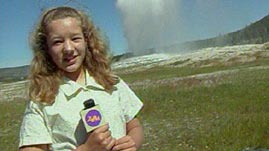Teachers' Domain - Digital Media for the Classroom and Professional Development
User: Preview


Source: ZOOM
Geothermal features, which include geysers, hot springs, steam vents called fumaroles, and boiling mud pots, are found on nearly every continent. Yellowstone National Park in Wyoming contains the world's largest collection: nearly 10,000 such features lie within its 2.25 million acres. In this video segment adapted from ZOOM, a young guide offers viewers a tour of the park and explains how Earth's internal heat fuels geothermal formations. The tour makes it clear why millions of people visit Yellowstone each year to witness the park's explosive displays and colorful deposits.
Underlying Yellowstone National Park in Wyoming is a thermal vent that runs from Earth's mantle to its crust. Some 600,000 years ago, this "hot spot" fueled one of the largest explosive eruptions in recent history. It has been 70,000 years since Yellowstone's crater-shaped volcano last erupted, but the park's 10,000 geothermal features, all heated by underground lava reservoirs, demonstrate that the volcano remains active.
In regions of current or recent volcanism, as cold rainwater seeps downward, it is heated by rocks that overlie magma chambers deep in the ground. Because water is subjected to greater pressure at these depths, its boiling point is higher than normal. As a result, instead of boiling, the underground water becomes superheated. The superheated water then rises toward the surface where it feeds into hot pools of water or escapes through narrow cracks in the ground.
Because minerals dissolve more readily in hot water than cold, hot springs often contain high mineral concentrations. When groundwater reaches the surface and cools, some minerals come out of solution and are deposited. Stepped terraces, like those present at Yellowstone's Mammoth Springs, are made of travertine, a mineral that is usually white when deposited but may be red, brown, or yellow if iron compounds or other minerals are present.
Hot springs that erupt intermittently with a great deal of steam and boiling water are called geysers. As superheated groundwater rises, the pressure decreases and the water turns to steam. The steam, in turn, propels the water that lies above it toward the surface. The eruption continues until most of the water and steam are emptied from the vent and storage chambers, after which groundwater begins to collect again and the process repeats. The period between geyser eruptions depends on the time it takes for the underground system to recharge.
Two other common geothermal formations in Yellowstone are mud pots and fumaroles, or steam vents. A mud pot forms when the rock surrounding a hot spring is chemically weathered by volcanic gases dissolved in the water. The weathered rock mixes with the heated water to form boiling, liquid clay. Although they are usually gray, some mud pots are called paint pots because certain undissolved minerals color the clay. Fumaroles lack an abundant groundwater source, and are thus vents from which only steam and other volcanic gases escape.
LAURA B.: Hi, I’m Laura B from Mammoth Hot Springs, WY. What’s Up in Yellowstone National Park?! Yellowstone was the country’s first national park. Back when it was established in 1872. Almost three million people come here every year.
Yellowstone Park covers almost 2.25 million acres. Within the boundaries of this park, there are miles of rivers, acres of lakes, and over two hundred waterfalls. Yellowstone has almost 10,000 thermo features and 4 different kinds: geysers, hot springs, fumaroles or steam vents and mud pots.
There are over three hundred geysers in Yellowstone. Old Faithful is known for how faithful it is. It goes off almost every 90 minutes and everyone in the park sees it. Old Faithful shoots up an average of 130 feet and even goes as high as 180 feet.
This beautiful hot spring behind me is called Grand Prismatic. Many people think it’s a swimming pool but if you went swimming in it you’d be fried to a crisp. The beautiful colors come from the bacteria that live in very hot temperatures.
This is a herd of elk. Elk are the long land animals in North America that have ivory. Right here (pointing to her incisor teeth).
The American Bison, the symbol of the west is the largest land mammal in the park. They’re bigger than a bear and heavier than a moose.
This is a big bull bison. It’s rolling o the dust to keep the bugs off.
I like Yellowstone because I can always learn about plants or animals. There’s always new things to learn. Bye!
 Loading Standards
Loading Standards Teachers' Domain is proud to be a Pathways portal to the National Science Digital Library.
Teachers' Domain is proud to be a Pathways portal to the National Science Digital Library.
